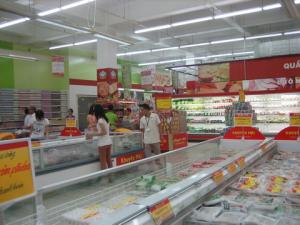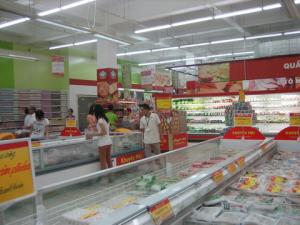Increased Prices, Cost of Living: Consumers Left to Suffer

In Ha Noi, Vietnam, the coming of the Lunar New Year always spells increase in the prices of consumer goods. But as the value of the Vietnamese dong continues to depreciate, this increase comes even earlier, with the cost of living also becoming more expensive, and ordinary or low-income citizens facing the biggest burden. According to Ta Van Sy, a laborer at Ho Chi Minh City’s Tan Hao Industrial Park, he had no choice but to send his wife and children back to their province to cut back on costs. His family depends entirely on his measly income of VND2 million or U.S.$102 a month.
He has to work even on Sundays just to make ends meet. Pham Thi Vy, another ordinary worker earning the same salary as Sy, all her money goes to payment for food, electricity and water. While that alone is difficult enough, she is responsible for her brother’s schooling, taking another portion of her small salary for the tuition. She decided to transfer and share a matchbox 10q.m room with a friend just to save some money. Prices for basic commodities like rice, cooking oil, meat and vegetables, just to name a few, have sky rocketed. As of mid-August, room rates near the industrial parks and export processing zones in Ho Chi Minh City soared between VND50,000 and VND100,00 or U.S.$2.5 and $5.1, respectively.
Thus, workers and ordinary citizens have to change their spending habits and lifestyle altogether. According to economist Ngo Tri Long, former deputy head of the Market and Price Institute, the rise in prices is due to a number of reasons. The exchange rate between the Vietnamese dong and the U.S. dollar is definitely one factor, an important one at that, if not the biggest and most determining factor. He said Vietnam has been exposed to dollarisation or the holding of foreign currency by residents. This means that “the impact of rate adjustment may have been even stronger once imported goods are sold and people convert dollars to dong.” According to Long, “the rate adjustment has devaluated the dong, causing increased input costs to produce goods.”
Other causes of the price increase according to the economist are the loss of consumer confidence and the hoarding of rice among traders, causing a snowball effect on other basic commodities to increase in prices dramatically. Deputy Director of the Ha Noi Industry and Trade Department Nguyen Van Dong states that the total commodity circulation in February will be about VND19.2 trillion or U.S.$960 million. That is about 20-22% increase compared to the past months. Pork for instance, has to be imported from other provinces because Ha Noi has only been able to meet 70% of the city’s demand. This inability to meet consumer demand is one of the main causes of hoarding, traders spreading “false information to raise prices and earn illegal profits.”
This, according to Vuong Tri Dung, deputy head of Ha Noi Market Watch. To solve this economic dilemma, the Ha Noi government has decided to let businesses borrow VND400 billion (U.S.$20.5 million) with preferential interest rates so they can stock up on good in time for the Lunar New Year period. But Nguyen Minh Phong, an expert at the Ha Noi Socio-Economic Development Institute, disagrees with this plan, stating that this will not be enough to stabilize market prices. Instead, he offers an alternative move, suggesting that the State should satisfy demand for foreign currencies among enterprises and think of emergency measures to stabilize the prices of basic necessities like electricity, coal, water, oil and gas.










